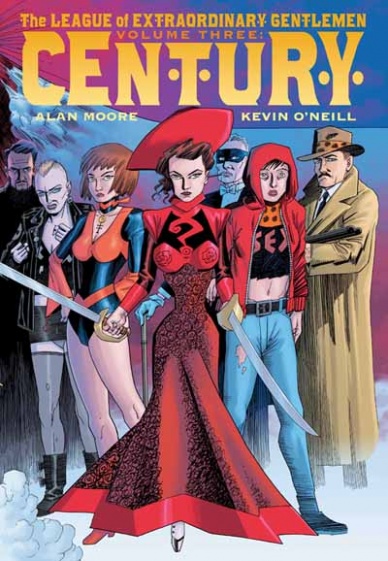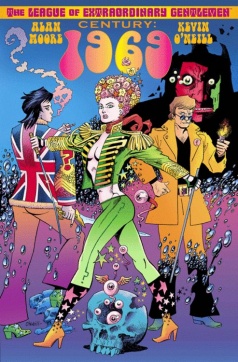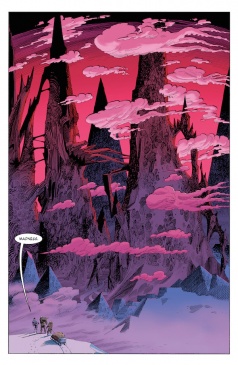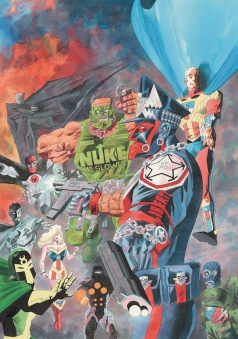
Primarily known for his work on the “League of Extraordinary Gentlemen” series, Kevin O’Neill is one of the most talented and important working artists in comics today. Between four volumes of “League” books and the two recent Nemo-centric graphic novels, O’Neill’s career in comics continues to impress with his incredibly intricate and multi-layered pages that bring the iconic re-imaginings of literary characters to life. And with another “Nemo” title on the way as well as more “League” in store, we were quite honored to host a chat with Kevin O’Neill all about his seminal work in the industry on this series.
Read on as we chat with Kevin O’Neill about his career in comics, the upcoming collection “League of Extraordinary Gentlemen v3: Century,” the Nemo series and the future of the League. Oh, and “Marshall Law,” because “Marshall Law” is excellent.
Before we get started, something I like to ask the very first time I talk to them is a pretty simple question. It’s just: why comics?
Kevin O’Neill: Why comics? Well, comics combine all my interests: animation, production design, special effects, sunt work and stage craft in one discipline. The great thing being you can do it all with just pen and paper, making it in my youth a financially viable way of expressing myself. I did however have a phase making 8mm movies, but the sheer expense and frustration with my lack of resouces nipped that in the bud! Also, I went to a very strict Catholic school, and comics were slightly forbidden fruit which made them all the more appealing I guess. Slightly subversive, as well.
And again, when I was quite young, someone in the school playground had a copy of a MAD Magazine paperback, one of the old Ballentine paperbacks. Seeing that made me really want to draw comics. I think it was the most incredible thing I’d seen in my entire life up to that point. I must’ve been about 9 or 10 years old?
I find it interesting because, looking at League or even looking at something like Marshal Law, a lot of your artwork draws very heavily from pop culture, referencing movies or shows, books or history. How did you develop this style where you can bring to life a character that isn’t yours in a style that obviously very much is?
KO’N: I think for my generation, you cannot underestimate the influence of MAD. It had the most profound effect on us. Alan Moore, Dave Gibbons, everyone was effected by it, and we’re all roughly the same age. Growing up in the 50’s, early 60’s was a really rich period in pop culture.
My influences were a bit scattershot, really. I was very into the Famous Monsters of Filmland. I can remember my dad saying he’d seen seen the original King Kong when it first appeared in 1933. I remember him talking about it and it sounded like the most amazing movie ever. I saw pictures and stills from it in Famous Monsters, and they screened it here on TV. My parents let me stay up late to watch it, so things like the staging of King Kong — and Ray Harryhausen films, as well. I’m a big fan of those. Jumping ahead a bit, when I was in my late teens I did a fanzine called Just Imagine that was all about special effects, since I was really interested in movie special effects. I knew Ray Harryhausen lived in London as I’d seen him interviewed on television, so I just looked him up in the phonebook. He was the only Harryhausen in London. [Laughs] So I cold-called him, and he was the most charming man. His background was very similar to mine. He was a fan.
I think that kind of rubs off on you, that warmth that people show you. Not everyone was like that in the business, and the one or two people I’ve met in the film business are nothing like that. I was thinking about this the other day; there was a documentary about Ray’s work, and I could see in my own stuff that a lot of the staging in those movies, I kind of subsumed it in my own way, in my work. It’s almost the staging of live action stop motion, glass paintings, miniatures. I could see that, watching all those films, and how they influenced me back then and had a profound effect.
Continued belowThere were so many great people in that period when I was growing up. It was sort of a dazzling time for pop culture. And pop culture then was fairly low, only certain people took it seriously. I did a fanzine on special effects because I couldn’t go out and find any books on the subject, you know? So I started doing something on my own to give to people, to meet people and spread more knowledge of who these people were and what they did.
That’s all kind of long-winded. [Laughs]

No, no, it’s great! So jumping ahead a bit to more current times, “Century” is about to be collected for the first time here in the states. I was wondering, looking back on it now, since that book was such a huge, sprawling effort for you and Alan, how do you see that book in comparison with what you’re working on for the Nemo series?
KO’N: It’s interesting, because I just read a proof copy of the book. I sat down and read the three chapters back to back for the first time in some years, and I found it more relaxing to sit back and read it now than it was to actually work on it. The first one, it was fun because it was close enough to the Victorian era that I was comfortable. But when we made the jump into 1969, which is relatively recent past… Once you start involving so many more fictional things, there’s just so much more to choose from in that period, and we had to skirt around all kinds of issues as well in what we can and can’t use. I can remember that was really hard; I think it was the most labor-intensive of all the League books. 2009 was slightly more relaxing since it was more or less outside the window, if you know what I mean.
But when we were talking about 1969, it was interesting. All the archive footage that you see over and over, the Austin Powers look, was a real minority thing. The rest of London just kind of looked like the 1950s or the 1940s in parts; a lot of bomb damage, a lot of scarred things. We wanted a flavor of that. And there was a wealth of fictional material we could work into it. I just remember it being very hard work, especially since we did “Century” back to back with “Black Dossier”, and “Black Dossier” was that moment of madness. Just an insane thing that grew and grew from where it started, which was just a 48-page book originally; it was never meant to be a big project.
Shifting from “Century” to Nemo, I just said to Alan that it’d be nice to get out of Britain, out of London, and roam the world a bit more. That was why we switched before doing more League, which will happen after the current Nemo I’m working on.
I’m curious: “Century” features, and obviously this is stuff that has been mined and annotated incredibly online by folks like Jess Nevins, but it’s full of references and little cameos and things like that throughout all three books. What is the collaboration like between you and Alan when putting in the smaller references? I’m assuming here that he doesn’t put in every single cameo in the script; how much of that is just you shaping these worlds as you like?
KO’N: There’s a certain bit of freedom there. I think with the original League series, it just started with a small Charles Dickens reference, and some older Victorian comic characters. I remember talking about it and we felt, well, if we have a newstand scene, it would be great if all the publications are fictional publications from all over the place — and therein lies the path to complete and total madness, really. Once we started that, Alan puts in so many references and a lot of stuff, and as we go along if there’s a street scene or a newstand or a window dressing or department store names, well. I’ve watched a huge amount over the years, including some very poor films, but they have these fictional company names in them, and I’ll keep notes because someday there will be a use for them.
Continued belowThe whole idea is, you can read the main story and it doesn’t matter if you don’t recognize the department store in the background; it’s just a department store. But if you do recognize it, it’s certainly more entertaining. It does change the overall feeling of the world, it’s an entirely fictional construct as far as humanly possible. We use fictional travel agencies, fictional everything. The more up to date we come, the more difficult and the more time consuming that becomes. There’s more get. But then you look at everything, every car, every this and that, it’d be nice to make a connection with something fictional. Whether it’s a film, TV, newspaper magazine, whatever.
I know with some people, there was some criticism early on that it was maybe turning for them into something like Where’s Wally, you know? Do you have to know all these references to get it? But that was never the intention. It’s purely a texturing, a layering; just giving richness and depth to the scenes.
And I imagine that it can become labor-intensive after a while, especially with 2009. That one seemed like it had maybe the most references that people who hadn’t studied certain eras of history or literature could “get.”
KO’N: Right, I would’ve thought so. For me, 1969 was the most difficult because there were so many things we could use, but both those books took a lot of time. We’ve shifted so far now from the Victorian supergroup scenario. The books got a lot darker. In a way, again, the Nemo books were to have a break, to go off with this other character, Janni from 1910. Just pursue a different style for a while. The next League book, we’re talking about it and it’ll be such a big project. Doing those big projects back to back already almost killed me. [Laughs]

So looking at the Nemo books, one thing I found fascinating about the two that we’ve had so far is that I think they’re much more focused, at least in terms of what it’s revolving around. It’s not an era, so you’re not involving so many things, but the first book is very Lovecraftian, and the next is Fritz Lang influenced. Obviously you are a fan of these sort of things, but what sort of research goes into bringing all these ideas of Lovecraft or Lang together into one central space?
K’ON: Alan’s a huge Lovecraft fan, and my first published fanzine artwork was for a Lovecraft fanzine in the early 70’s. I’ve read Lovecraft, and I was going to say Lovecraft wasn’t a problem but Lovecraft is a problem. Lovecraft works so wonderfully inside the head, but drawing the unspeakable, unimaginable horrors is always a challenge. That is always going to be a problem putting it down on paper. I did find the Mountains of Madness, the collapsed city, incredibly fascinating in trying to do something with it to give just a hint of what he was suggesting.
The other stuff, working around Fritz Lang films and German cinema, it’s always been an interest of mine and I think of Alan’s as well. It wasn’t a huge stretch. It was a lot of fun to work with that material. I suppose we’re back on more of an adventure footing with these books, since they’re not set in contemporary Britain; it’s become a bit more of a high adventure, which is very entertaining to draw. I get to do a lot of big stuff, it’s a more operatic serial than we’ve done recently in “League.” I’m halfway through the final one now, and that’s going really well. It’s another big one.
The audience is wonderful, though. The audience continues to follows us.
Obviously, for me as a reader and a fan, I can look at the Nemo books and “Century” and I can compare and contrast them on my own about the inherent differences. But for you, as the co-creator of the series, as the illustrator of these books, was there anything in particular that you found you were doing different when approaching the creation of the Nemo books, as opposed to “Century” or any previous League books?
Continued belowKO’N: There’s much more room for me to play with pictures in the Nemo books. More spreads, for instance. 2009 didn’t have any spreads at all in it, it was very, very packed, and it was 72 pages. These are 48 pages, but there is a huge amount of space for artwork. There’s quite a lot of breathing space in them. I like the Janni character and her relationship with Broad Arrow Jack. It’s kind of analogous to Mina and Quartermain, so we got a nice dynamic going there with them. I also like how it fills in stuff that we’d never have covered if we’d gone straight into another League book. We’d introduced Janni in 1910 but not really seen her in action, and I found her really interesting.
With the Nemo books, this is the second time that you guys have approached the story as a trilogy. “Century” was a trilogy, Nemo is a trilogy. Is there anything you find in a trilogy that is particularly conducive to the type of story that you want to tell, as opposed to a six-issue miniseries like the first two League books?
KO’N: Originally, the idea we were thinking of was one Nemo book, and then switching over to a Western. We did talk about doing a Western book starring Orlando, but I think the trilogy is really Alan. I think it’s Alan’s natural instinct for things, to do another Janni book. He had an idea in his mind of an arc for the character and it evolved into a trilogy that way, so we follow her from a young age to the final book where she’s an old woman, that “final mission”.
The next book being “River of Ghosts,” and you said you’re about halfway through it? I don’t know how much you can say about it yet, but I’d be remiss if I didn’t at least ask.
KO’N: Well, I think we have said that it is in South America, that it’s 1975 so Janni is very, very old. It’s difficult to talk about any more, since they are short books so to say much more will give a lot away. But, yes, it’s the 70’s, it’s South America. [Laughs] It’s pretty damn wild. It’s the wildest one of the three so far. We’re having a lot of fun with it. We’re making really good progress, which is a good sign. I think I’m surprising Alan this time with keeping pace with how fast he’s writing it, which is unusual to say the least.
But it’s great. After doing a Lovecraft story, a second World War story, and now a South American jungle story effectively, it covers all the bases in adventure storytelling.

And I don’t know if this is prying too much, but with the other two books having a central influence, can you say what the central influence of this one is? Or is it too early to say?
KO’N: It’s probably a bit too early to say. It’s an interesting time, 1975. I was just doing some design work around the rest of the book. It was a curious time, the mid-70’s.
So looking past the Nemo book, what do you have coming afterwards? Are there more League books planned, or were you thinking about doing another book outside of the League universe?
KO’N: At this stage, the plan is that when we finish this one there will be another League story. A big one. We’ll be back with Mina again. I can’t say much more than that, other than I’ve been slightly putting it off for a while. It’s something that is going to be very, very complicated; a big deal story. So we’ve got that. It’s going to be a few years work. I never plan that many years ahead, though. [Laughs] It’ll be interesting to get back to it, especially after doing these books. As Alan’s put it, it’s cleansed our palette, refreshed things so we can go back to it with some vigor.
And, before we wrap up, one thing I really want to talk about (which has nothing to do with League and nothing to do with Nemo) but it was a year ago or so that DC published that big Marshal Law reprint, and that was the first time that I was actually able to get a physical copy of Marshal Law. I’d been a fan since League, but Marshal Law is a whole different side of what kind of work you’re capable of, what kind of work you like to do. You read the intro by Jonathan Ross and it talks about the time period, but I can only imagine that seeing this collection of the book, seeing all this material again — how did you feel about coming back to Marshal Law after all this time.
Continued belowKO’N: It’s very, very weird! I was looking at it, especially some of the later books, and I’m thinking we probably would’ve had much more of a problem doing this material today than we did then. It does seem extraordinarily over the top. I’d forgotten how demented we were. We never really had many problems with it, hardly any alterations in hundreds and hundreds of pages. There was the Mask crossover where they changed a word or something on a shop sign, but we never really had any problems — and the further we went, the further we wanted to go. So we went as far as we could and, well…
Do you remember that period, where Marvel was distributing their own comics. And they were doing variant covers, embossed covers and god knows what, and suddenly the whole market collapsed? Pat and I, we were doing a Marshal Law signing and crossing America, and comic stores were closing down as we were moving state to state. Comic stores were closing for all kinds of problems. And suddenly, it was very difficult to get Marshal Law published, just because of the economic climate. That was really why I was available to do League, actually; Pat was doing work in France, I was doing fill-in work for DC, and that led to me working on League with Alan. I mean, otherwise we probably would’ve continued with Marshal Law, and god knows where would’ve ended up.

But it was a huge amount of fun, and it all goes back to MAD and going further and further. Since Pat didn’t grow up with superheroes, he didn’t read those superhero comics at all when he was a kid, it was all new to him. He was looking at it through a different set of eyes. We worked out stories for years in advance, we had loads and loads of things we were going to do. But, it had its moment back then, and suddenly that was it.
I think it’s coolto see it collected again. I think people had completely forgotten about it. It went off the radar for most people. It had its followers, certainly, and we met interesting and strange people at signings, many tattooed and pierced.
I take it that Marshal Law is probably not something you’re going to return to beyond this collection and the new covers?
KO’N: No, it’s a time thing, really. DC had asked if we’d do new stuff, but it’s just finding the time. And also, I know what we’re like, how far we’d like to go, and I’d hate — No, I wouldn’t do it in an emasculated version of what it used to be. I think what people like about it is that it was excessive, it was wild and freeform in a way. It’s probably the most bombastic stuff I’ve ever done. We cut it pretty fast, perhaps too fast in some stories, but for the most part we really, really gunned it. We got the maximum out of it. I think we were running against the tide on that one.
I’m glad to see it collected. I know they’re doing a softcover at Christmas this year, so that will probably reach a wider audience. But I enjoyed doing the cover, I enjoyed seeing it all again, and they did a fantastic job of putting it together.






